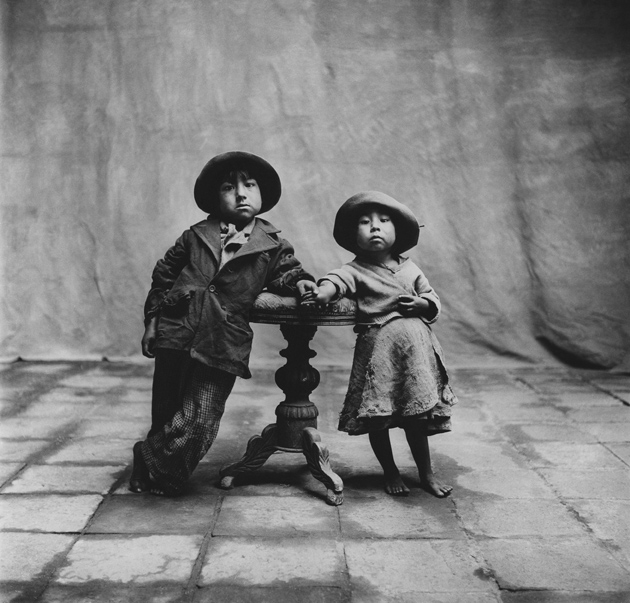Irving Penn was assured a high place in the canon of photography well before his death, on October 7 at the age of ninety-two. Yet for those of us who came of age during the 1960s, he seemed the Apollonian counterpart of his Dionysian contemporary and principal competitor, the younger and groovier Richard Avedon, who died five years before Penn almost to the day. They were the twin gods who ruled high-fashion photography after the postwar resurrection of the Paris haute couture, when they brought unprecedented formal power and graphic impact to what had been dismissed as an intractably insipid genre—“visions of loveliness,” in the sneering phrase of Penn’s mentor and tormentor, Alexander Liberman, longtime editorial director of Condé Nast Publications.
Paradoxically, although Penn and Avedon elevated fashion photography to an art form, they were plagued by neurotic unease about how they earned their daily bread. Their fabulously successful careers—replete with critical acclaim, museum exhibitions, scholarly studies, prestigious awards, blue-chip dealers, and record-breaking prices—would have been much harder had they not been subsidized by lucrative associations with mid-century America’s top two fashion magazines: Penn at Condé Nast’s Vogue and Avedon at Hearst’s Harpers Bazaar. Those sizable incomes were further supplemented by their advertising photography (uncredited at both men’s insistence) for cosmetics and clothing manufacturers.
All the while Penn and Avedon sought recognition as “serious” artists through effortfully unbeautiful subject matter they thought more consequential than glorifying the rag trade. By day Penn orchestrated ravishingly stylized fantasias of sleek goddesses in billowing Balenciagas. By night he shot an antithetical 1949–1950 series of ample, sagging female nudes, cut off at the neck and printed in harsh bleached-out tones, which he withheld from public view for three decades. His shows at New York’s Museum of Modern Art and Metropolitan Museum of Art, in 1975 and 1977 respectively, featured large platinum prints (an obsolescent technique he single-handedly revived) of cigarette butts and other trash scavenged from city streets. Nonetheless, those grungy still lifes were less memorable than Penn’s Vogue food illustrations, among them a Brancusian pile-up of a black olive atop a tomato atop a ball of mozzarella.
Avedon’s finest fashion photos, as seen in a recent retrospective at New York’s International Center of Photography, exude a contagious joie de vivre rarely found in his archrival’s faultless but often chilly compositions. But the frost melted in Penn’s electrifying depictions of his adored wife and perpetual muse, Lisa Fonssagrives-Penn, who had been a leading mannequin in pre-war Paris. They met in 1947, at his shoot for a Vogue tableau, “Twelve of the Most Photographed Models of the Period.” As Penn recalled to me for a 1990 Vanity Fair profile, “When Lisa came in, I saw her and my heart beat fast and there was never any doubt that this was it.”
Fonssagrives, six years older than the photographer, was touched by his ardor, which gave her career a renewed burst of energy as she approached forty. They married in 1950 and remained devoted to each other until her death, forty-two years later. Penn’s collaborations with his wife hint at a conspiratorial complicity not wholly dependent on one’s knowledge of their private relationship, which suffuses her exquisite features with what can best be described as the look of love. In the late 1960s, he created color images of cut flowers in advanced stages of decay, set against white backgrounds like herbarium specimens, a sequence some interpreted as his meditation on Fonssagrives-Penn’s fading but still arresting beauty.
During more than six decades with Condé Nast, Penn shot a veritable pantheon of cultural giants, including Picasso, Stravinsky, and Balanchine. Early on, he posed his subjects within the acute-angled confines of a studio prop he devised to induce uncomfortable expressions that suggested creative anxiety. Later he settled into a kinder formula that seldom varied: evenly lit heads in tight close-up against a shallow, neutral backdrop. Many saw this repetitive format as innately conservative. But Maria Morris Hambourg, the Metropolitan’s first photography curator, convincingly likened Penn’s portraits to ancient Egyptian bas-reliefs in their monumental presence, smoothness of surface, sharpness of outline, and absence of spatial depth.
However, no Penn portrait surpasses his masterpiece, Cuzco Children (1948). Taken in an antiquated photographer’s studio he borrowed during a working trip to Peru, this black-and-white image of a diminutive Indian boy and girl—barefoot, hatted, and hands clasped atop a Victorian tripod table—could easily have descended into heart-tugging bathos, a Save the Children fund-raising poster. Instead, Penn treats his solemn-faced subjects with as much respect and dignity as Mathew Brady did when he immortalized Abraham Lincoln, and the same tenderness and affection with which Velázquez portrayed the Spanish infanta and her mastiff in Las Meninas. If anyone ever wonders whether Penn—obsessive technician, yeoman artist, and perfectionist nonpareil—had a heart, this picture provides irrefutable proof positive.
Advertisement
This Issue
November 19, 2009




